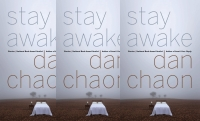Interview
Dan Chaon’s latest story collection, Stay Awake, has been described as “superbly disquieting” (New York Times), presenting “…the intricate, dark corners of grief….” (San Francisco Chronicle).
Michael Schaub of NPR Books said in his review, “… Chaon has a rare gift for creating characters who are complex, unique and real, and he depicts the weight and strain of their trauma with sensitivity, authenticity and, sometimes, terror.”
The stories in this collection were written over a span of a decade but the connections are strong and clear. What was it about these nightmare tales that kept you coming back to write more?
I knew early on that I eventually wanted to publish a collection of ghost stories. I came up with the idea after I published “The Bees” in 2003, and so every once in a while I’d try my hand at a piece, in between working on a novel.
But honestly, I didn’t realize how strong the connections were until I sat down to put all the stories together and see if I had enough for a collection. Then I was actually a bit alarmed to notice how many repetitions and recurring images there were—wow, I thought, I sure am obsessive!
My first instinct was to change the details to make these echoes less noticeable. Then, after thinking about it, I began to like the idea that they had a kind of déjà vu quality, that they were forming and reforming around the same knot of feeling. In the end, as I was revising the collection, I ended up adding even more of these echoes and connections from story to story. The final story, “The Farm, The Gold, The Lily-White Hands,” contains elements of all the previous stories –it’s like a mash-up of everything I was thinking about over the course of writing these. As a former DJ, this made me really happy.
In several of the stories you use the image of someone (a wife or paramedic or nurse, always a woman) leaning over and examining one of your uneasy dreamers. It made me uneasy every time, made me think of night hags and succubi. Is this what you had in mind?
The sinister, vampiric quality was certainly one aspect I had in mind. But I was also thinking of the flip side, too: the image of a mother hovering over a sleeping child, or a kind person caring for you when you are ill and helpless, or a lover kissing you just as you are about to drift off to sleep. This is one of those images (see above) that I’ve found myself returning to over and over, probably because it seems so full of contradictory emotions—dread and comfort seemingly coexisting, Janus-headed, flipping back and forth. I guess that’s what a succubus does best, right?
A common thread in these stories is consciousness fractured by grief and loss. The ability to make sense of life disintegrates. Language and communication disintegrate. Is the possibility of losing language something that gives you bad dreams?
It’s not so much a horror of losing language as of finding oneself in a place where there is no language for what you’re experiencing, a place where language is utterly inadequate. That’s what grief is like in a lot of ways, I think. When my wife Sheila died, I lost a whole part of the world—a whole complex net of memories and associations and conversations that were unique to our relationship, and that can’t ever be replaced, or even explained to someone else. I think it’s not unlike what people experience when they have a major stroke. A piece of your brain, yourself, has gone blank.
In several of the stories, particularly “Patrick Lane, Flabbergasted,” it’s not at all clear where the story is coming from and where it’s going. Something’s happening and you don’t know what it is. Did you approach these stories (or did they approach you) from an unusual direction?
In “Patrick Lane”—and a number of other stories—I was interested in trying to describe the experience of the uncanny, that thing that you feel but can’t put your finger on, that sense of something existing behind or above ordinary reality, that moment when you have a presentiment that something is wrong, terribly wrong.
So the stories are often an accumulation of moments that don’t lead to real epiphanies or conclusions, but only take the characters on a journey into a place that they can’t ever turn back from. Edward P. Jones says that a story is about a change, large or small, in the life of a character, and I think the scariest thing is when you intuit that something has changed, but you’re not sure what it is. I think of the ending of the Raymond Carver story, “Fat.” “My life is going to change,” the narrator says. “I can feel it.” Yikes!
A couple of years ago when we spoke about your novel, Await Your Reply, you mentioned that in that case, landscapes came to you before plot. There is a much more tentative sense of place in this collection. Did you deliberately keep the stories unanchored?
And speaking of novels vs. stories, which is your favorite child these days?
I’m surprised to hear you say that you didn’t notice landscape as much here, because it was certainly on my mind. A couple of stories—“Patrick Lane, Flabbergasted” and “I Wake Up” are very much about the Cleveland milieu; “Shepherdess” draws very specifically on my own experience in an emergency room in Los Angeles; and “Take This Brother, May It Serve You Well,” was originally simply a love/hate letter to Portland, Oregon. I do think the landscapes that I write about have changed over the years, but I still feel like most of these stories have, in my mind at least, strong landscape images behind them.
As far as having a favorite child—the short story has always been my first love. It’s just that I need that sugar daddy of the novel to pay the bills.
“The Farm, The Gold, The Lily-White Hands” immediately took a spot on my personal list of best ghost stories ever. Fascinating in terms of structure and in its meandering point of view–hypnotic, mysterious in so many ways. Actually physically spine-tingling for me at one point! How did this story develop and was it as breathtaking to write as it is to read?
I’m so glad that you liked the story, because it’s one of my favorites, too. It’s funny, because the story actually started out as a game I was playing with my students for Halloween one year. I told them I was going to write twelve ghost stories, one for each student in the class. And I wrote these twelve little vignettes…then found that I really liked some of the pieces…then began to play with them and make them more and more interconnected. The final piece doesn’t resemble the original very much, but the form remains the same: tiny stories, like an ensemble film, which slowly intertwine. It was super fun to write, and it’s my favorite of the pieces in the book.
Story after story you keep on turning the screw. But there are times when a grotesque sense of humour surfaces. This moment of macabre hilarity in “Stay Awake” stood out for me:
“After the head was removed, would they bury it?” he wondered vaguely. “Would it require a headstone?”
How do you see the role of humor in horror?
Humor and horror are different sides of the same coin. For example, Road Runner cartoons are only funny if you don’t identify with Wile E. Coyote. I was always aware that the grim situations I was writing about had their funny side, and there are some stories in the collection that I thought of as straight-up humorous, like “Long Delayed, Always Expected,” and “Slowly We Open Our Eyes,” and “Shepherdess.”
Reviewers often mention how bleak the stories are, but its humor that has kept me going. Even if it’s gallows humor.
I admired Cormac McCarthy’s apocalyptic novel, The Road, but I think there are a few things he got wrong. I think the end of the world will include a lot of great jokes. And singing. Laughter and music are probably the last human thing that will be taken away from us.
Please tell us a little about “Dreaming Awake” the course you’ll be teaching at the Indiana University Writers’ Conference this June.
I’m running a workshop that is going to be an exploration of the daydreaming process. We’re going to be practicing ways in which we naturally imagine and create narratives—and how that can lead to creating short stories and novels and other kinds of art.
Thanks for your time, Dan and thanks for the stories!
–
Dan Chaon can be found online here, he also tweets .
–
Carol Reid is a contributing editor for Emprise Review.







